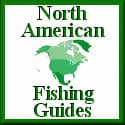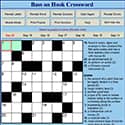Bass on Hook is Supported by our readers. As an Amazon Associate We earn commissions from qualifying purchases. For more informtion read our Amazon Affiliate Disclosure and Affiliate Disclosure Policies.
Spring Halibut Fishing Techniques
By Paul Smith
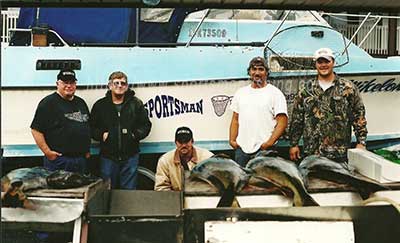
Early spring is the time of the herring spawn on the west coast of Vancouver Island and all the predator species move in to feast.
The salmon, rockfish and halibut will move in shore to gorge themselves on the abundance of bait fish that are present.
The killer whales, seals and sharks will also move in to take advantage of the large numbers of salmon, rockfish and halibut that are milling around the spawn.
Such is the cycle of Mother Nature's food chain where everything depends on something else for survival.
It is this time that most anglers in the know will dust off their boats and check their gear to ensure that everything is in working order.
Providing Mother Nature allows them, they will then head out to try their luck at filling the fish wells.
Weather and Tides Can Affect Spring Halibut Fishing Tecniques
The weather can dictate whether you will reach your favourite spot or have to fish inside for feeder springs (Chinook salmon).
Wind is the big factor that affects your fishing adventure and sometimes can reach up to 30-60 miles an hour, creating swells that tower above your boat.
If the weather is cooperative, you will undoubtedly have the time of your life.
Once you have determined that the weather won't affect your fishing opportunity, you will head out to your favourite reef or contour line.
The tide will also decide where you will fish.
It is best to fish for halibut on the ebb tide usually half an hour before and after the slack.
There are certain tides that will allow you more time to fish either side of the slack.
These are usually very short running tides of 6.5 ft. at low to 8.5 ft. at high.
This allows you to place your gear on the bottom while maintaining a perpendicular line.
Fishing line is also important as monofilament line will stretch while braided line will provide an accurate feel of the bottom.
Your gear will consist of jigs and or spreader bars with bait on fairly stiff rods.
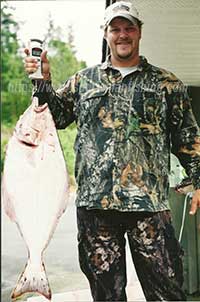
Different Sized Jigs For Spring Halibut Fishing Techniques
Jigs come in various shapes and sizes.
The 8-12 ounce size remains the most popular with smaller versions being used in the shallower waters.
A lot of locals will create their own jigs out of copper pipe and fill them with lead.
Usually the hook is situated on top of the jig to avoid catching on the bottom.
There are many different types of jigs on the market that work well for halibut.
My favorites are the "Lucky Jig" and "Gibbs Jigs".
Lucky Jigs are hexagon style pipe jigs with the hook and a coloured skirt at the top.
The Gibbs line of jigs that I like include Mudraker which is similar to the Lucky Jig in shape, glow squid which uses a tapered cyclinder shaped weight that glows and herring jigs which are shaped like a herring.
When a whole herring or part there of is applied to the hook of your jig your odds of catching a halibut increase tenfold.
Halibut are attracted to the scent and the thumping sound your jig makes when lifting (jigging) it up off of the bottom.
Try and stay in the 80-180 foot range when fishing for halibut and only moving off to the 200-300 foot range later in the season as the halibut move back out to deeper water.
Fishing in 200-300 feet of water can wear out your arms very quickly especially when you hook into a "barn door" (100+ lber).
Using a Spreader Bar Technique
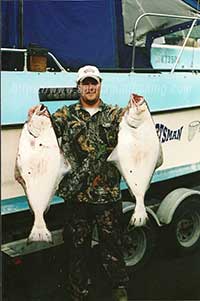
By far my most favourite technique for halibut fishing is using a spreader bar with a whole herring, cut plug herring or squid on a couple of treble hooks with a 10 inch leader of 40-80 lb test.
For those of you not familiar with a spreader bar, they look like a coat hanger cut in the shape of the uppercase letter L with the weight being put on the short end and the leader on the long end.
Don't use a coat hanger however as the strength just doesn't compare to the stainless steel used by the company that manufactures them.
Once again I will use 8-16 oz or heavier weights to keep my gear on bottom and get it there fast.
Depending on the tide movement you should always lower your gear to find bottom again as you have a tendency to drift into deeper water.
Remember you always want to be on bottom or within 5 feet of it.
Once you find the bottom you will want to jig or lift your rod up and let it down slowly making sure you can feel it touch bottom.
Fishing for halibut is usually done on a gravel/sandy bottom so rarely do you loose your gear.
If you are hitting a solid bottom then all you will catch is rockfish, which isn't necessarily a bad thing.
You will also loose more gear when it hooks a crevace or seam in the rocky bottom.
With a spreader bar you can place it in the rod holder and let the swell action do the work for you or you can just leave it on bottom.
Action attracts fish though so a jigging motion will produce better results.
Another popular way to fish for halibut is to troll along the bottom using a downrigger with a circle hook or large treble hook and squid or octopus for bait.
This technique will also produce some nice sized Ling Cod or Salmon.
What To Do After Hooking A Spring Halibut
Once you feel the tell tale sign of a halibut biting, you should set the hook by lifting up on your rod and keeping your rod tip up while reeling.
Make sure to set the hook a couple of times in the beginning while reeling up to ensure a proper hookup.
When you know the halibut is hooked you can pump the rod if you wish as long as on the down stroke you can reel fast enought to keep your line tight.
I see too many fish lost because of slack line.
When the halibut gets close to the boat be prepared for a strong dive towards the bottom as they suddenly get a burst of energy when they see the huge shadow (boat) on the surface of the water.
Always make sure your drag is set appropriately for a strong run.
Sometimes anglers loosen off their drag to aid in reeling in the halibut and forget to reset it once it gets close to the boat.
Once again I've seen too many fish lost when they loose control over the reel because of a birds nest or tangled line as it spools off the reel out of control.
Never gaff a halibut over 50 lbs as you will be in for a rude awakening when it decides to flop around in your boat or on the end of the gaff hook.
I always have a gaff and harpoon handy in case of the big one.
My harpoon will be attached to about 10-15 feet of heavy line, which is attached to a large Scotty or plastic float of some kind.
This way a large halibut will only be able to tow around the float for so long before it tires and surfaces, which is your cue to start reeling towards the boat again.
I've even had situations where the harpoon has been set and the hooks popped out of the halibut and twenty minutes later the float surfaced and we motored over and retrieved a nice 150 lb halibut that was too tired to put up much of a fuss.
I usually like to cut the gills and let them bleed before I bring them on board.
This accomplishes two things:
- It helps to kill them
- It makes the meat taste a lot better
For those of you fortunate ones who are legally allowed to pack a gun on board your vessel this is the sure way to make sure the halibut is dead before attempting to bring it on board.
To Sum Up Spring Halibut Fishing Techniques
Hopefully, this will give you some energy to dust off your boat and take advantage of the good spring fishing for halibut, which I'm sure have the same habitats up and down the Pacific coastline.
Follow these guidelines and you will be eating fish and chips before you know it.
As for the east coast that's another story.
One I'm not yet familiar with (yet)!
Thanks for reading and I hope I taught you something you didn't know!
Keep your rod tips up and tight lines!
Paul
If you have a question or comment for Paul please feel free to send it via our Pro Staff Question And Answer form.
Your questions will be answered within 24-48 hours by Paul.
Look for other articles written by Paul Smith in Paul's Pro Staff Angler Profile





